If you travel to the mountains or snowy areas regularly, sooner or later you’re going to have to use tire chains. Start by getting the right set for your vehicle at your local Les Schwab.
Quick-fit chains are not your grandpa’s tire chains. They are MUCH simpler to put on and take off. Here are a video, step-by-step instructions, and driving safety tips for installing quick-fit tire chains on your vehicle.
When you need chains, driving conditions are nasty. Snow is coming down, passing traffic is spraying slush, dirty water is dripping off your wheel wells, the road is slick, and it may be dark. Don’t make this the first time you put on your chains.
Practice installing your new chains once BEFORE you travel. Take advantage of a dry garage or driveway to make sure your winter tire chains are the right size and you’re comfortable putting them on. If needed, the professionals at Les Schwab Tire Centers can help.
Put together a simple winter road trip safety kit with warm gloves, waterproof layers, and other items to make your winter driving more safe and comfortable. In the winter, always carry this emergency kit and tire chains in your vehicle.
Once you’re comfortable installing your chains, you’re ready to hit the snow.
Be Safe. If you’re on the road, pull off as far as possible onto a safe shoulder. Flip on your hazard lights. Put on your waterproof layers, hat, headlamp, and gloves from your winter road trip kit.
Identify the Correct Tires. If your vehicle is front-wheel drive, the chains go on the front. If it’s rear-wheel drive, chains go on the back. If it’s all-wheel drive, please check your owner’s manual. If you’re not sure, you can ask the experts at Les Schwab for help.
Pull Out Chains & Instructions. With your vehicle parked, open the bag and pull out your instructions and your first chain. Each bag comes with two chains. The plastic instruction mat that comes with your chains can be used as a barrier between you and the snow to keep you dry.
Untangle Your Chains. Holding them from the plastic-covered cable, make sure everything is straight and the chains are not looped over one another. Hold up your chains so the yellow end is in your left hand and the blue end is in your right.
The chains should hang loosely and the metal hooks seen along the yellow and blue sections should be facing away from you so they don’t damage your tires.
Place Chains onto Your Tire and Connect the Cable. Lay your chains on the ground and push them behind the tire, yellow cable end first, from the right side to the left.
Once the chains are centered behind the wheel, grab both ends and pull them up over the top of the tire. You should feel the chains against your axle.
This will allow you to easily connect the yellow and blue ends of the cable by slipping one end into the other and pulling them into place.
Connect the Red Hook. Now that the cable is connected on top, look for the red hook directly opposite the cable connection. Connect the red hook on the right to the first available gold link on the left.
Check the Diamond Shape. Push the connected chain over the top of the tire. You should see the diamond shape in the chains against your tire. Between each of those diamonds is the center rail, which should be placed down the middle of the tire tread.
Connect the Red Chain Along the Bottom. Now that the cable is connected on top, look for the red hook directly opposite the cable connection. Connect the red hook on the right to the first available gold link on the left. Push the connected chain over the top of the tire.
Now that the cable is connected on top, look for the red hook directly opposite the cable connection. Connect the red hook on the right to the first available gold link on the left. Push the connected chain over the top of the tire.
The bottom of the chains includes a red draw chain with bungee on your right, and a chain guide on the left. Pull these out towards yourself.
Take the long red chain and run it through the chain guide and pull as tight as you can with both hands. Don’t pull using the bungee. As you pull, one of the chain links will find its way into the notch on the red chain guide, locking it into place.
Using the bungee end of the red chain, pull it through one or both of the red loops and secure it to a gold-side chain opposite the red loops. If you can’t get it through both loops, that’s ok, pull tight through one and attach it to a side chain to the left of the loop.
Repeat on Second Tire.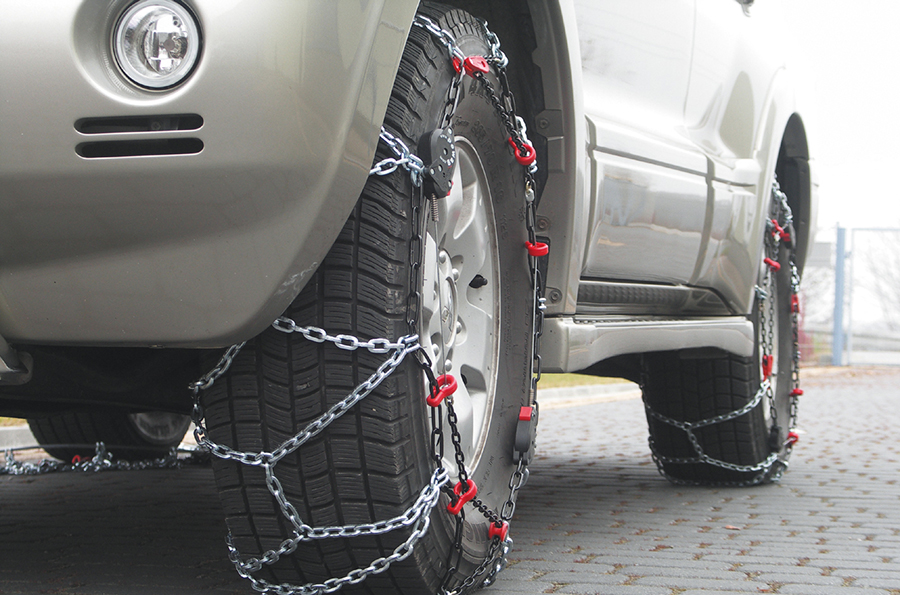 Repeat these steps to install chains on the other side of your vehicle.
Repeat these steps to install chains on the other side of your vehicle.
Drive Forward Slightly. The next step is to drive forward about 15 feet, or a full car length. This gives the chains a chance to relax and settle on your tires.
Re-tighten Chains. To take up any slack, unhook the rubber end of the red draw chain and pull it tight again. Once it’s tight, guide the red chain through the loops and, again, securely latch the bungee end to the gold-side chain.
The chains should be tight on the tire. And, be sure to stop if you hear them making any contact with your vehicle. If your chains are still loose, unhook the bungee and adjust the red hook straight across from the chain guide. Unhook and reattach to the tightest position on one of the three gold chain links. It’s okay if the extra links are hanging loosely. Now, you’re ready to reattach your bungee.
While driving with tire chains, listen for a loud sound of slapping, or metal on metal. If you hear any indication that a chain may be broken or hitting your car, STOP as soon as safely possible. Loose or broken chains that flap can wrap around a strut or shock component, causing big damage to your vehicle. To help prevent damage, here are a few tips for driving when you have winter chains installed on your vehicle.
Pull over in a safe location and remove the chains. Start by unhooking the bungee and chain from the guide, removing them from the tensioner. Unlatch the red hook, and then undo the blue and yellow cable connection. Once all of your chains are off and lying flat on the ground, pull backward or forward slowly a few feet so you can safely pick them up.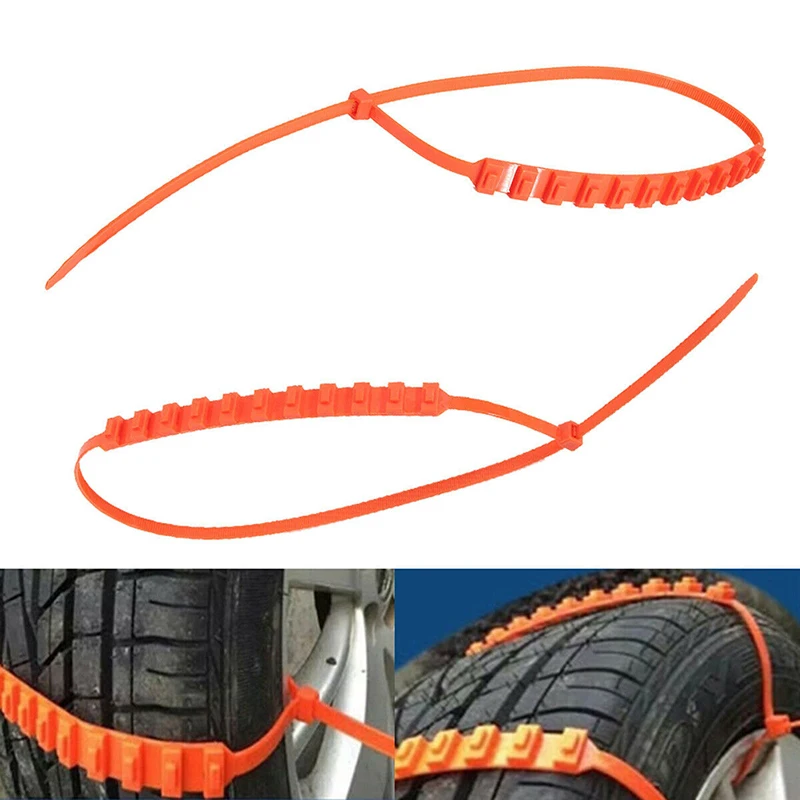
At the end of your trip, lay your chains out in the garage and let them dry. If you pack them wet, they can rust.
Also check them for wear, especially if you’ve driven them on asphalt for any distance. Look for flat spots, and replace the chains if you find some.
Link at left shows flattening from wear. Link in center shows sharp edge from wear that can damage a tire.
Remember, if you don’t use your chains all winter long, you can return them with proof of purchase to any Les Schwab for a full refund in the spring.
Get your next set of Quick-Fit chains, along with a few tips on how to install them, at your local Les Schwab, where doing the right thing matters.
Want more tips on winter road safety? See 19 Winter Driving Resources You Can’t Do Without.
Get More Winter Tips
Outside's long reads email newsletter features our strongest writing, most ambitious reporting, and award-winning storytelling about the outdoors. Sign up today.
Sign up today.
You’re heading up to the mountains for the weekend and a storm hits. A sign flashes across the roadway: chains required ahead. Uh-oh. Chain control isn’t something you can bypass or ignore. If your car can’t make it over the snowy, icy roads safely, you’re not going anywhere.
Most chain-control checkpoints require you to have either a four-wheel-drive vehicle with adequate snow tires or chains properly installed. If you have 4WD but no snow tires, prepare to chain up. Some states require by law that you carry tire chains in your car if you’re driving in snow country—whether you have 4WD or not. Other states that don’t regularly have wintry conditions prohibit the use of chains because they can damage roads if used when they’re not needed. So check your state’s chain law before you head into snowy or icy conditions. We called up Steve Nelson, public information officer for the California Department of Transportation, for advice on what you need to know before chaining up.
If you’re renting a car, the rental company may provide them; otherwise, buy chains before you head into the mountains. You can’t purchase chains at a checkpoint—although you can often pay to get them installed there. Most tire shops and some well-equipped gas stations sell chains. Check your tire size in the manual (or on the tires themselves if they’re aftermarket) to make sure you get the right fit. You’ll likely only need to install chains (sold in pairs) on two of your tires: the back two if you’ve got rear-wheel drive and the front two if you’ve got front-wheel drive. Refer to your manufacturer’s recommendations for all-wheel drive. It’s best to consult a professional when purchasing to make sure you get the right size and chain pattern for your vehicle.
Carry Emergency Supplies“Carry blankets, gloves, warm layers, extra food, and water” if you’re headed into snow country, says Nelson.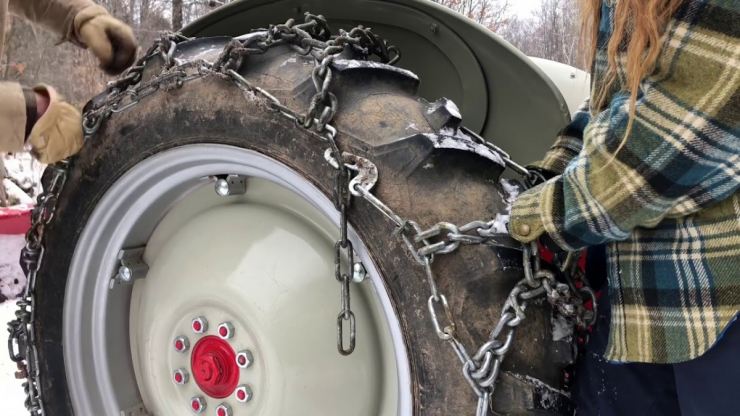 “You’ll also want a full tank of gas and fully charged phones. There can be times when we have to shut down the interstate, and you’re stuck out there. So come prepared for anything.” Make sure you’ve got a sturdy pair of gloves in your trunk for installing chains. Leather hardware-store staples, like Kinco’s 1927KW gloves ($18), get the job done, or if it’s really wet out, you might opt for a waterproof, insulated glove, like Showa’s Atlas 460 ($13).
“You’ll also want a full tank of gas and fully charged phones. There can be times when we have to shut down the interstate, and you’re stuck out there. So come prepared for anything.” Make sure you’ve got a sturdy pair of gloves in your trunk for installing chains. Leather hardware-store staples, like Kinco’s 1927KW gloves ($18), get the job done, or if it’s really wet out, you might opt for a waterproof, insulated glove, like Showa’s Atlas 460 ($13).
In limited places, chain installation at checkpoints is available for about $30 (removal will cost about $20). But in most cases, you’ll need to be able to install them yourself. “We always tell people to do a dry run, putting on your chains before you actually go out,” says Nelson. “Practice in your driveway. You don’t want to be out there in nasty weather and wind doing this for the first time in your life.” Each set of chains comes with instructions, and there are plenty of YouTube videos to help you along.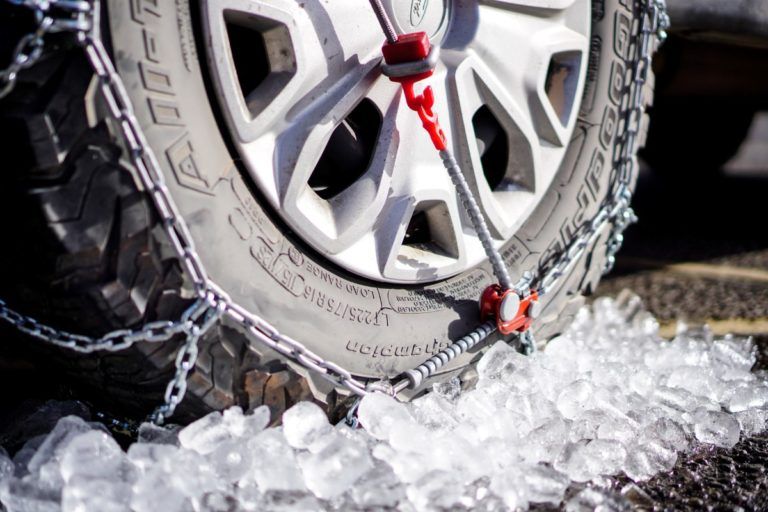 Or stop into your local tire shop for a demo.
Or stop into your local tire shop for a demo.
Find a safe place to pull over on the side of the road. “The biggest thing is to pull all the way off the shoulder into the designated areas we’ve provided for installing chains,” says Nelson. Straighten your wheels, lock your parking brake, untangle your chains, and lay them flat on the ground. The plastic instruction sheet that comes with your chains can be good to kneel on while you work. Place the chains over the top of the tire, making sure they’re centered. Clasp the attachment system—be it a hook or clamp—on the outside of the tire, facing you. Tighten and lock, following the specific instructions for your chains. Depending on what type you have, you may need to roll the car forward a foot or so to secure them entirely. Once they’re on, drive a car’s length, then stop and check to make sure they’re snug and locked properly.
Take It SlowChains aren’t meant for fast driving. “In chain control, the speed limit is usually 25 miles per hour,” says Nelson. “Slow down and drive for the conditions.” Pull off the road if you hear any clanging or loud metal sounds—that’s a clear indicator that something needs your attention.
“In chain control, the speed limit is usually 25 miles per hour,” says Nelson. “Slow down and drive for the conditions.” Pull off the road if you hear any clanging or loud metal sounds—that’s a clear indicator that something needs your attention.
When signs indicate that chain control has been lifted or roads are dry, it’s time to remove your chains. Leaving your chains on when there’s no snow or ice on the road can damage the road, and in some states, it’s against the law. “We always have chain-on and chain-off stations that will be signed and marked,” says Nelson. Once again, “pull over and look for the designated wide shoulders and safe locations.” When you get where you’re going, be sure to hang your chains in a warm, dry place so they don’t rust.
For cars
For SUVs
For trucks
FOR LOADERS, TRACTORS, SPECIAL EQUIPMENT
Functionally, snow chains are, in fact, a removable tread that allows you to turn an ordinary road tire into an off-road wheel.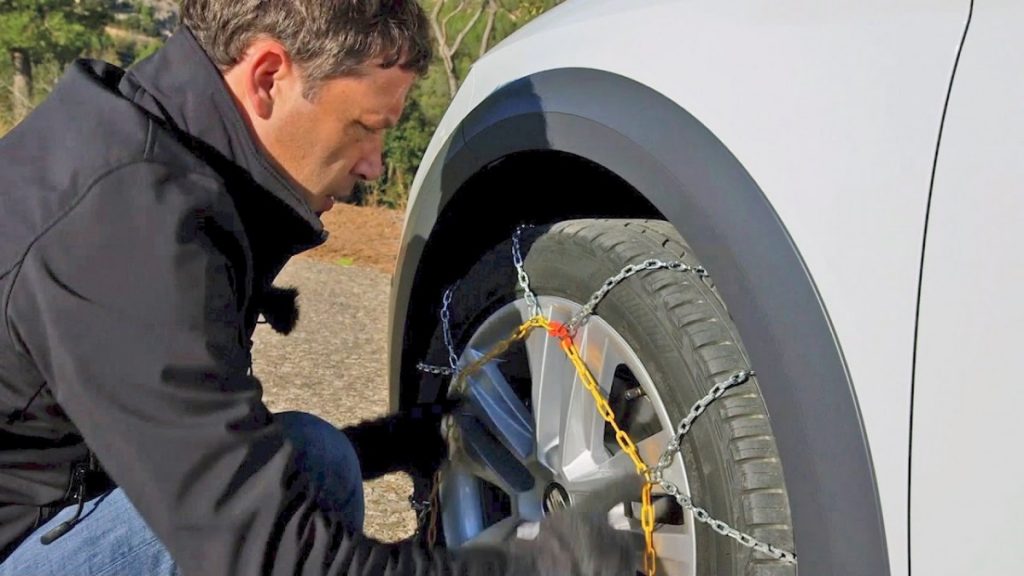
The purpose of the anti-skid chain is to significantly increase the grip properties of the wheels (and, accordingly, the vehicle's cross-country ability) on ice, loose snow, deep mud, etc. In practice, it may look like this. You go fishing - you drive 100 km along the asphalt surface on ordinary tires, and then turn into a country road, where the very “hard off-road” begins. Then snow chains are put on - and you can go further, having much less chance of skidding or getting stuck in the mud. And places such as, for example, icy steep climbs, without snow chains, it is very problematic to overcome even on studded tires.
First of all, snow chains are divided into two classes: "hard" and "soft" . The former use the actual chains as cross members, while the latter use reinforced rubber “lugs”.
There are two basic patterns (see picture): Ladder and Diamond/Honeycomb.
In the first, the longitudinal chains / cables are connected with straight transverse pieces, in the manner of a rope ladder.
In a "rhombus" they are connected obliquely, getting a "spider" pattern. Chains also differ in size and shape of the link (or lugs).
Different materials are used for chains - steel, titanium (expensive), aluminum and reinforced plastic. Sometimes chains are additionally reinforced with metal spikes.
It is impossible to say unequivocally which snow chains are better. Everything is individual and depends, first of all, on driving conditions.
So, “hard” chains are better suited for off-road than “soft” chains, but they do not allow you to move at speeds over 40 km / h. “Soft” ones make it possible to drive at speeds up to 80 km / h and wear out rubber much less than “hard” ones. Therefore, for those who left the highway and went to knead deep off-road, the “hard” option is better. For those who drive in a way where sections of flat roads and muddy country roads constantly alternate (for example, in the region), “soft” ones are more suitable.
The same can be said about the dimensions of the chain links. The larger the link, the more “off-road” qualities, but the more weight, the worse the ride on a flat road and the higher the wear of the rubber.
The larger the link, the more “off-road” qualities, but the more weight, the worse the ride on a flat road and the higher the wear of the rubber.
When it comes to cars, snow chains can be used on just about any car. Except, perhaps, some sports cars (and hardly anyone would think of going hunting in a sports car). When it comes to tires, it’s safe to say that “hard” chains are not suitable for ultra-low profile wheels that are 50 inches or smaller. But a “soft” model can be found even in this case.
Chains are graded for cars, SUVs and trucks. But here the wheel size plays a role, first of all: the chain covers from two to four standard sizes along the radius. In addition, for SUVs and trucks, chains are made with large links, often with additional spikes.
It is not necessary to install snow chains on all wheels of the car - only on the drive axle. This is useful when driving on not very “steep” off-road, when used from time to time “according to the weather”, as well as for overcoming problematic sections of a country road.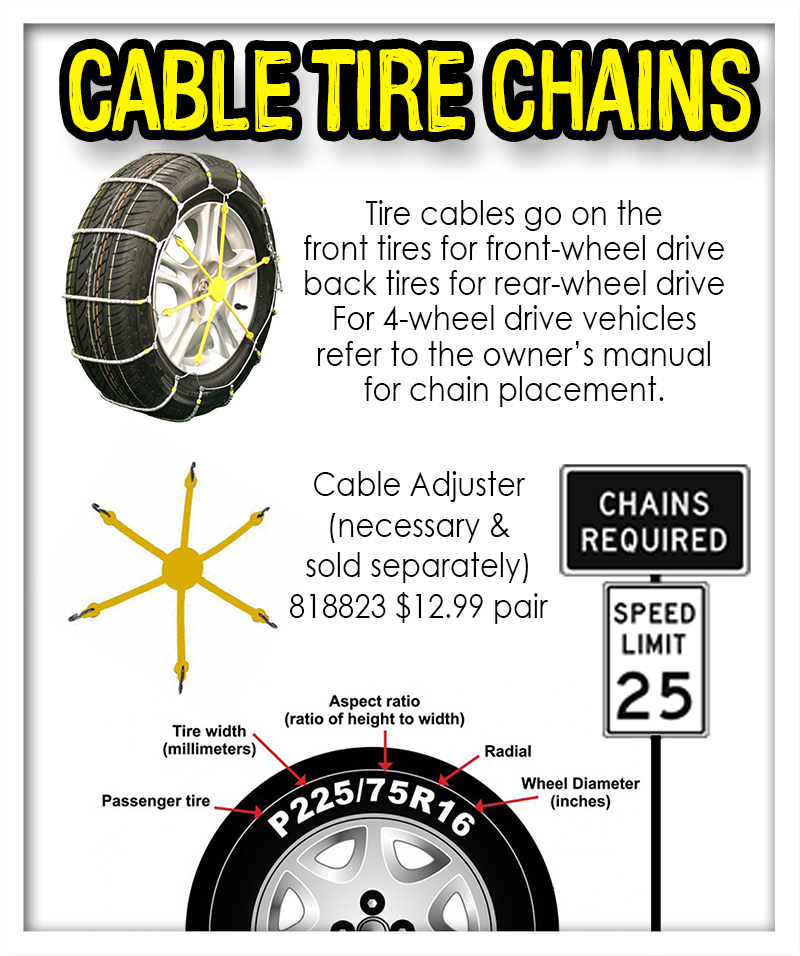
In order to put snow chains on the wheels of a car, the chains are laid out in front of the wheels of one axle exactly along the axis of motion, so that the locks on the outer side chain are on the outside (along the side) and “look” forward. The hook of the rear side chain must be on the inside (toward the bottom). Next, you need to drive the wheels on the chain so as to stop 20-30 cm from their end. After that, put most of the chain on the wheel and hook the hook from the inside. Then you need to straighten all the links on the wheel (for “soft” ones, put on the adjusting cable / chain), and then hook the lock of the outer side chain. Then you need to do a “rolling”, after driving 10-50 m, so that the chain settles down, and then tighten the locks again. Experienced SUV owners put on chains with a bang, and for them it is no more difficult than tying their shoelaces. But for many motorists, especially at first, putting on snow chains turns out to be the main “stumbling block”, and there are many who refuse to use them precisely because of this procedure.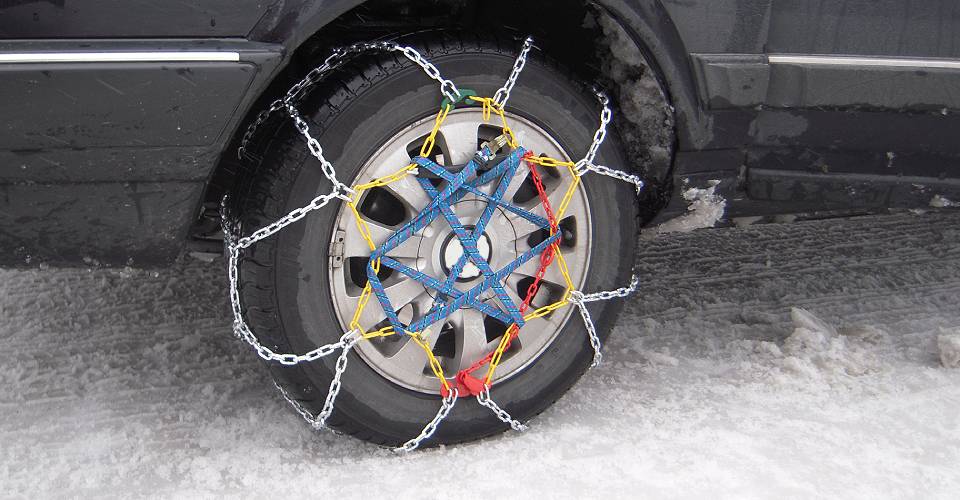 In any case, before using the chains, you should first practice putting them on somewhere on the site - it will be easier on the road.
In any case, before using the chains, you should first practice putting them on somewhere on the site - it will be easier on the road.
As for tires, we can say right away: all chains wear out rubber. “Hard” more, “soft” less. Wear also depends on the frequency of use of snow chains. The rubber actively begins to “eat up” during prolonged driving “in chains” on a hard road, sudden braking and acceleration, with too little contact with the wheel.
In the car, the main danger here is the violation of instructions and faulty chain locks. Do not exceed the speed prescribed by the instructions for the chain. In this case, under the action of centrifugal force, the chain can “break away” from the wheel and hit the wheel arch. In the worst case, the chain lock will break, and it will catch on the suspension parts (for example, the arm), which can lead to serious damage and even an accident. The condition of the links, locks and the reliability of fastening must be carefully checked.
An effective way to significantly increase the car's cross-country ability is to install snow chains on the wheels. The tool is simple, but you usually have to mount it on wheels literally in the field. How to do it quickly and without stress and nerves?
A paradoxical thing: many drivers are so afraid of the procedure for installing chains on wheels that they are ready to abandon the chains in favor of some simplified devices such as bracelets, nets and the like. Although in fact it is the chains that are the easiest to install. However, this is true only if you know the basic techniques for putting a car in a chain.
Snow chains on wheels significantly increase the vehicle's cross-country ability, but do not turn it into a tractor.
Before installing this powerful piece of equipment on your machine, consider whether the chained wheel looks like a photo or another machine.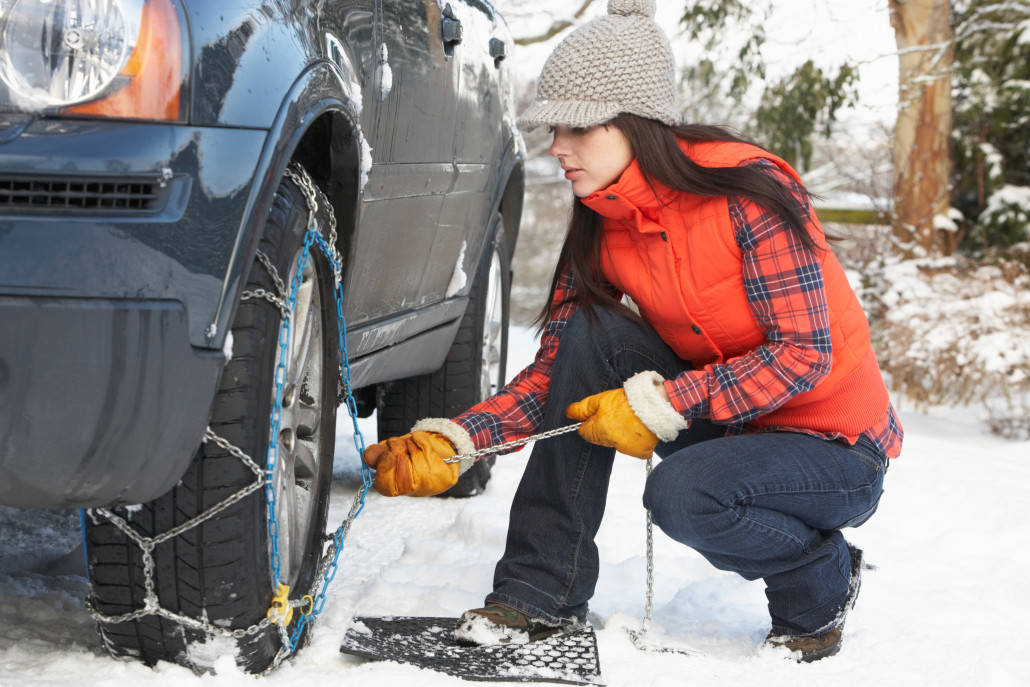 Understand the appearance and placement of each element of the chain: the working part, the side branches and the lock. Regardless of the brand, it is customary to highlight each element in its own color - to simplify putting the chain on the wheel.
Understand the appearance and placement of each element of the chain: the working part, the side branches and the lock. Regardless of the brand, it is customary to highlight each element in its own color - to simplify putting the chain on the wheel.
See also: What not to do when driving on fresh snow
If you know the chain design and terminology, you can immediately go to the second part of the article, where we talk about mounting them on the car.
The working part is located on the tread, its elements cross the tread of the tire across or almost across, but usually there are several longitudinal links. The working part of the chain has a neutral color, as a rule, this is the tone of the galvanized metal coating.
Properly dressed chains look like this. Side branches (red and blue) keep the working part on the tread
The side branches are ring-shaped and respectively hug the tire on both sides - they keep the working part of the chain on the tread. The outer side branch, like the working part, is made of the chain itself, the inner one, which is not visible on the car, is made of a rigid cable in a plastic sheath. The inner, cable branch is detachable, but has a fixed diameter. The outer branch is chain, consists of two parts and closes through a carabiner and a lock, thanks to which it easily changes the length (that is, the diameter). In addition, there is a hook with a rubber shock absorber on the outer ring. Lateral branches are usually colored: blue, red or yellow.
The outer side branch, like the working part, is made of the chain itself, the inner one, which is not visible on the car, is made of a rigid cable in a plastic sheath. The inner, cable branch is detachable, but has a fixed diameter. The outer branch is chain, consists of two parts and closes through a carabiner and a lock, thanks to which it easily changes the length (that is, the diameter). In addition, there is a hook with a rubber shock absorber on the outer ring. Lateral branches are usually colored: blue, red or yellow.
Lock is designed to tighten the outer side branch (reducing its diameter) and fix the achieved diameter. Actually, it is located on the very side ring. Locks come in various designs, including those with automatic tension. They are often made in a bright color, usually red.
See also: In the Carpathians with skis: we go to a resort with cars
There is nothing complicated in this operation, the only unpleasant thing about it is the need to squat near the wheels and the need to hold cold metal with your hands. Therefore, it is desirable to have gloves for such a case, preferably leather.
Therefore, it is desirable to have gloves for such a case, preferably leather.
The algorithm for installing chains on wheels is generally simple. We advise you to use gloves and some kind of padding under your knees
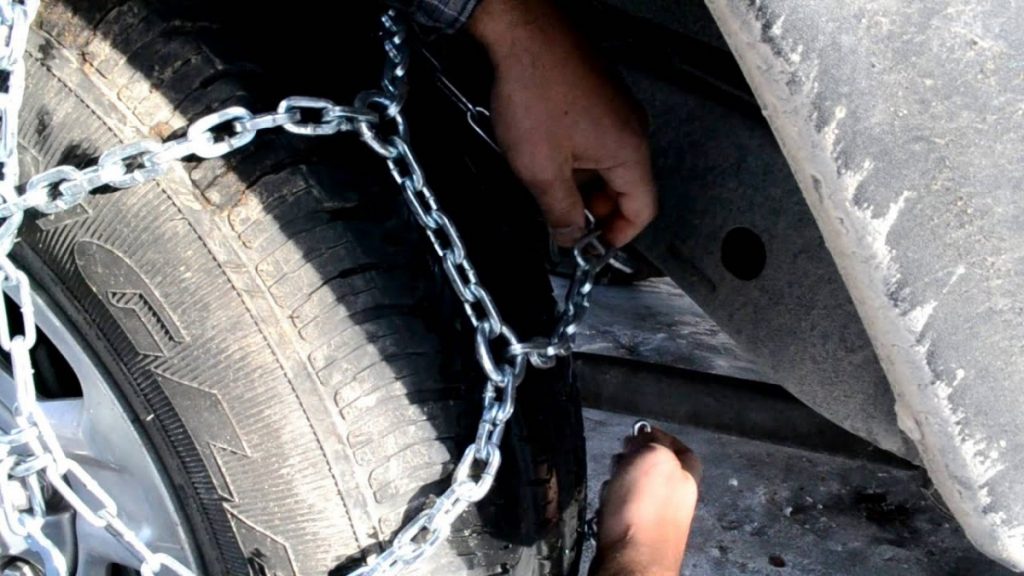
After putting on the chains, drive up to ten meters and tighten the side branch in the lock again (red in the photo)
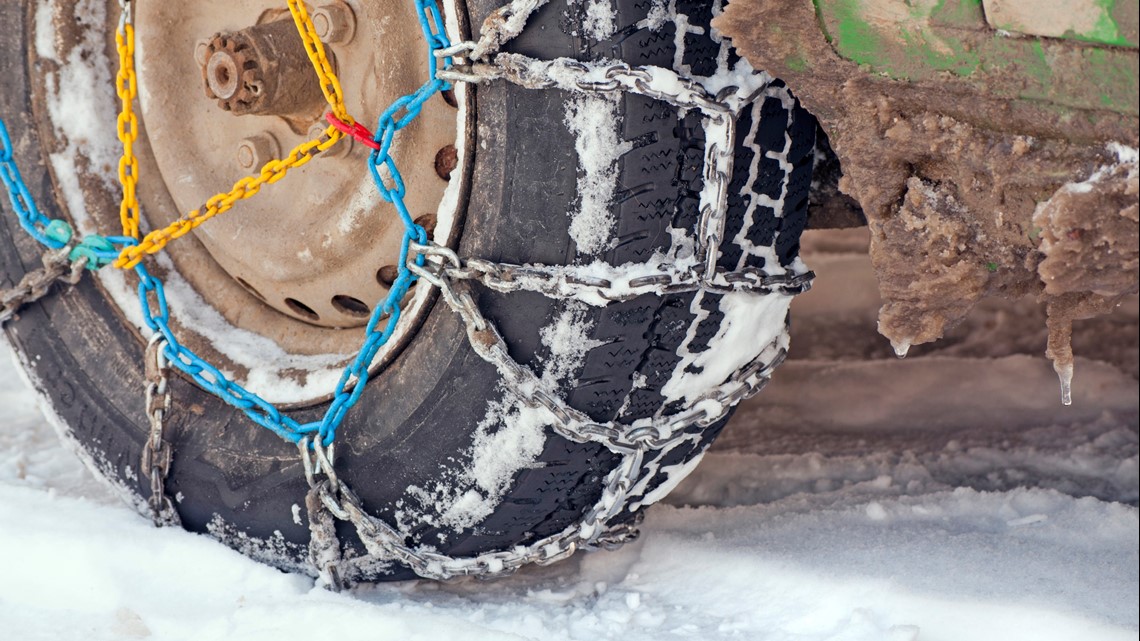
If your kit has a self-tightening lock, the last two operations are not necessary and you can go straight away. But it’s better to stop after a few minutes of driving, get out of the car and make sure that the chains fit the tires well. Keep in mind that in many cases the chain can scratch the wheel rim, which is not very pleasant for the owner, especially if the rims are alloy. But with a strong desire, you can almost always pick up a chain of such a size that it will not be located outside the bar.
Most chain manufacturers allow a speed limit of 35 - 50 km/h.
Also remember that it is very important not to drive too fast with the chains on the wheels, as this will damage the tires, rims, and even the fenders of the car. It is also very undesirable to drive with chains on wheels on clean asphalt (short sections do not count).
In order not to get tangled in the chains, removing them from the case somewhere on the side of the road or in a deep rut, we strongly advise you to practice installing them on the car in advance - for example, at the beginning of the season or before leaving for snowy areas.